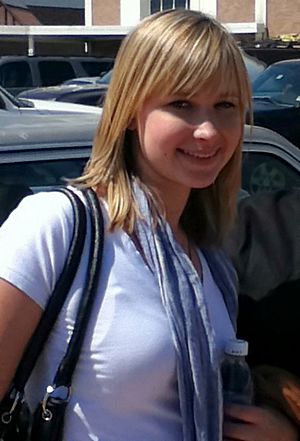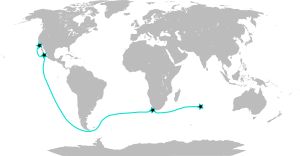Abby Sunderland facts for kids
Quick facts for kids
Abby Sunderland
|
|
|---|---|

Abby Sunderland at the Houston Boat Show in Kemah, Texas, U.S. on April 14, 2011
|
|
| Born |
Abigail Jillian Sunderland
October 19, 1993 Los Angeles, California, U.S.
|
| Education | Trinity Pacific Christian School |
| Known for |
|
| Parents |
|
Abigail Jillian Sunderland, born on October 19, 1993, is an American sailor. In 2010, she tried to become the youngest person to sail alone around the world. Her journey was full of challenges and showed her amazing courage.
Contents
Abby's Early Life and Family
Abby Sunderland is the second oldest of eight children. She grew up sailing with her family. Her older brother, Zac Sunderland, was the first person under 18 to sail all the way around the world. Abby and her brothers and sisters were homeschooled.
Her Big Sailing Adventure in 2010
Abby had dreamed of sailing around the world since she was 13. Her dad, Laurence Sunderland, knew how determined she was. He once asked her if she was ready to sail around the world after a very tough day at sea. Abby replied, "Where is my boat?" This showed how much she wanted to do it.
Some people worried about Abby going on such a big trip alone. They thought it might be too risky for someone her age.
Her boat, Wild Eyes, was a 40-foot (12.19 m) sloop. It was built in 2001 in Australia. The boat was designed to sail alone through tough waters like the Southern Ocean. Wild Eyes was made of fiberglass with extra strong Kevlar material. It had five special sections that could keep water out. Abby's family bought the boat in 2009 and added many new systems. These included electrical, communication, and navigation tools.
| History | |
|---|---|
| Operator | Abby Sunderland |
| Route | Cabo San Lucas – Cape Horn – Cape of Good Hope – Indian Ocean |
| Builder | A.S.A. Yachts PTY, Australia |
| Completed | 2001 |
| Acquired | October 24, 2009 |
| Out of service | June 12, 2010 |
| Status |
|
| General characteristics | |
| Type | Sloop |
| Tonnage | 16 (gross), 15 (net) |
| Displacement | 7407 lbs (3360 kg) |
| Length | 40 ft (12 m) |
| Beam | 11.21 ft (3.42 m) |
| Installed power | Yanmar (18 hp) |
| Propulsion | Sails |
| Sail plan | Bermuda (Marconi) rig |
| Notes | Formerly BTC Velocity |
First Try and Restart
Abby started her solo trip from Marina del Rey, California, on January 23, 2010. She had to stop in Cabo San Lucas, Mexico, because her boat's power systems were not working well. She needed more fuel and batteries. After fixing things, she restarted her journey.
Sailing On: Crossing the Equator and Cape Horn
Abby began her second attempt from Cabo San Lucas on February 6, 2010. She planned to sail around the world without stopping. On February 19, 2010, she crossed the equator into the South Pacific.
Later, on March 21, 2010, her boat was hit hard by a wave while she was sleeping. She managed to keep control. On March 31, 2010, Abby sailed around Cape Horn. This is the very southern tip of South America. This made her the youngest solo sailor to ever do so. She faced rough seas and strong winds there.
On April 24, 2010, Abby decided to stop in Cape Town, South Africa. She needed to fix her autopilot system. Even though she had to stop, she still planned to finish her trip around the world. She arrived in Cape Town on May 5, 2010.
Abby left Cape Town on May 21, 2010. She said she would stop again if she needed to.
Trouble in the Indian Ocean
On June 10, 2010, Abby was sailing in the remote Indian Ocean. Her boat was hit by very strong winds and waves. She lost contact by satellite phone. Her emergency beacons were set off. The nearest ship was far away.
The next morning, an Australian search plane flew out to find her. The plane found her boat about 10 minutes after reaching the search area. Abby was able to talk briefly by radio. She said she was okay and her boat was upright. However, the mast of her boat was broken, and the sails were dragging in the water. This meant her trip around the world had to end.
The area where Abby's boat was floating is not often visited by other ships. The Australian rescue team worked to get ships to her location. Abby was rescued by a French fishing boat called Ile de la Réunion on June 12, 2010. An airplane helped guide the fishing boat to her. Abby was reported to be safe and healthy. During the rescue, the captain of the fishing boat fell into the water but was quickly helped back on board.
Abby left her boat, Wild Eyes, behind in the ocean. She later wrote that "one long wave" had caused her mast to break. The Ile de la Réunion took Abby to the Kerguelen Islands. From there, she traveled on a French patrol boat to Reunion Island.
The rescue involved help from Australian and French taxpayers. By law, Abby or her family could not be charged for the rescue costs.
After the Journey
Abby Sunderland wrote a book about her adventure. It is called Unsinkable: A Young Woman's Courageous Battle on the High Seas. The book was released on April 12, 2011. She also became the subject of a documentary film made by her father, called Wild Eyes: The Abby Sunderland Story.
In 2018, Abby's old boat, Wild Eyes, was found overturned off the coast of Kangaroo Island in Australia. It had lost its keel.
Abby's Life Today
As of 2018, Abby Sunderland was living in Alabama. She is married and has three children.
See also
- Circumnavigation
- List of youth solo sailing circumnavigations


